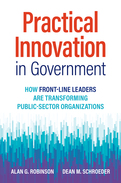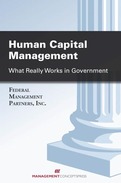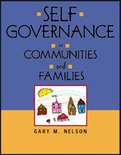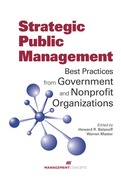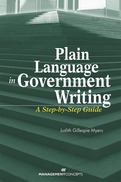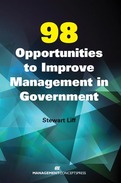Whether people want more government or less, everyone wants an efficient government. Traditional thinking is that this requires a government to be run more like a business. But a government is not a business, and this approach merely replaces old problems with new ones.
In their six-year, five-country study of seventy-seven government organizations-ranging from small departments to entire states-Alan Robinson and Dean Schroeder found that the predominant private-sector approaches to improvement don't work well in the public sector, while practices that are rare in the private sector prove highly effective. The highest performers they studied had attained levels of efficiency that rivaled the best private-sector companies.
Rather than management making the improvements, as is the norm in the private sector, these high-performers focused on front-line-driven improvement, where most of the change activity was led by supervisors and low-level managers who unleashed the creativity and ideas of their employees to improve their operations bit by bit every day.
You'll discover how Denver's Department of Excise and Licenses reduced wait times from an hour and forty minutes to just seven minutes; how the Washington State Patrol garage tripled its productivity and became a national benchmark; how a K8 school in New Brunswick, Canada, boosted the percentage of students reading at the appropriate age level from 22 percent to 78 percent; and much more.
We are entering the 21st century in a period of great uncertainty and change. People are wary of government and have lost confidence in social institutions-from social welfare and schools to healthcare programs. That loss of confidence has undermined the community and family life that is the very foundation of our society. Self-Governance in Communities and Families shows how individuals can reconnect to and revitalize their social institutions so that they are effective in serving the needs of all.
Gary Nelson identifies the existing social models we are moving away from and explores the new, emerging pattern of relationships we are shifting to in our social institutions. He reveals why open dialogue and partnerships between people and their social institutions are essential to the well-being of families and thriving communities. He describes why social regeneration is best pursued through these partnerships, with people and stakeholders within communities taking positive action to develop and protect the well-being of their families and the health of their communities.
Applying both business and social science concepts to the day-to-day management of social institutions, Nelson offers a proven, practical method-community self-governance dialogues-for engaging people in the redesign and revitalization of social institutions. The author shows how-by creating opportunities for individuals and families to proactively participate in developing a strategic plan for how their institutions are managed, run, and evaluated-this dialogue method ultimately empowers people to take control of their own lives. He also reveals how active participation in these open dialogues ignites creative ideas and new energy for the redirection and reshaping of those institutions.
With numerous examples and anecdotes, Nelson illustrates the values, beliefs, and principles that underlie how we learn and make decisions in a self-governing democratic culture. He provides tips for shared learning and accountability, ownership and governance, and the creation of a culture of self-governance. And he offers advice on how to maintain an ongoing engagement and partnership between the public and its social institutions.
Communities and families can be strengthened when each of us takes responsibility for ourselves and works in partnership with others to restore our social institutions. Self-Governance in Communities and Families sets forth clear, doable strategies for fostering both responsibility and ownership through dialogue and collaboration between public and private sectors.
- Provides community leaders and others with a framework for bringing all parts of a community and the "system" together around the common purpose of strengthening communities and families
- Outlines a philosophy of self-governance and empowerment for at-risk families, individuals, and neighborhood communities
- Offers managers a dynamic, adaptive model for opening up, supporting, and steering the process of social change
Complex management issues in the public sector can't be addressed with limited, short-term fixes. Strategic, well-conceived approaches are critical to meet your organization's long-term needs. Through expert advice and real-world examples, Strategic Public Management: Best Practices from Government and Nonprofit Organizations presents the solutions that today's public administrators are putting into practice to address a variety of challenges, including planning and managing core mission functions, integrating new technology, and pursuing measurable results.
Nineteen contributors representing local and federal government, nonprofit organizations, and the academic world offer guidance, direction, and examples that focus on the many areas of concern to public sector professionals, including:
• Program operations
• Human capital issues
• Risk management
• Acquisition hurdles
• IT solutions
• Performance parameters
This critical resource is easy to read and navigate, and the expert viewpoints provide essential best practices for mid- and senior-level professionals. Tackle your organization's complex issues today by applying proven strategies!
Whether you're in the public or private sector, good writing skills are critical to your success in the workplace. Plain Language in Government Writing: A Step-by-Step Guide shows you how to apply federal plain-language guidelines to every type of writing — from emails, memos, and letters to agency communications, technical procedures, and budget justification statements. Through numerous exercises as well as examples from a variety of federal and state agencies, this practical guide walks you step-by-step through every phase of the writing process, providing tips for improved clarity, conciseness, and completeness. This valuable reference will help you:
Write for diverse audiences in reader-friendly, plain language
Overcome writer's block
Gain confidence in your ability to write — and get results
Make your writing visually appealing
Prepare for briefings and presentations
Recognize successful writing and identify what makes it effective
A Plain-English Guide to Government Writing will enable you to express yourself more clearly and concisely, produce documents more efficiently, and work more effectively with others throughout the writing process.
Government managers face myriad challenges every day. Whether dealing with an ever-shrinking pool of resources or the threat of sequestration and shutdowns, the government manager must work to maximize staff performance to meet mission objectives.
Now, supervisors, managers, and leaders have some help. In this new book, veteran government leader, trainer, and author Stewart Liff offers practical and proven guidance aimed at helping people at every level of the organization. First-line managers as well as top agency leaders will find Liff's actionable suggestions invaluable in dealing with a broad spectrum of issues, including:
+ People management
+ Performance management
+ Resource management
+ Systems design
+ Organizational politics
Each of the 98 opportunities—and the included strategies, tools, techniques, and tips to help you take advantage of them—is valuable in and of itself. Together they provide a complete guide to managing effectively in the federal workplace.
Do your part to change government—one opportunity at a time!


